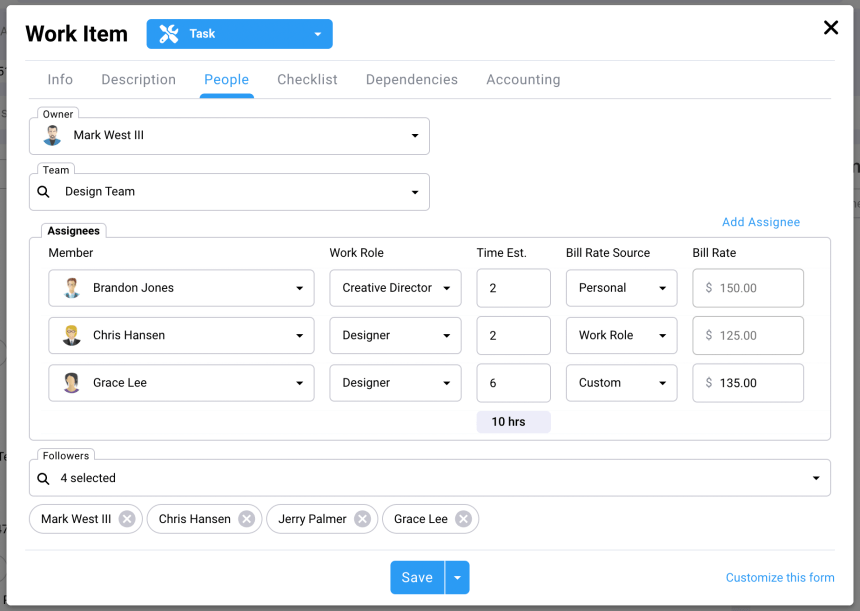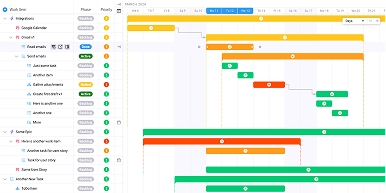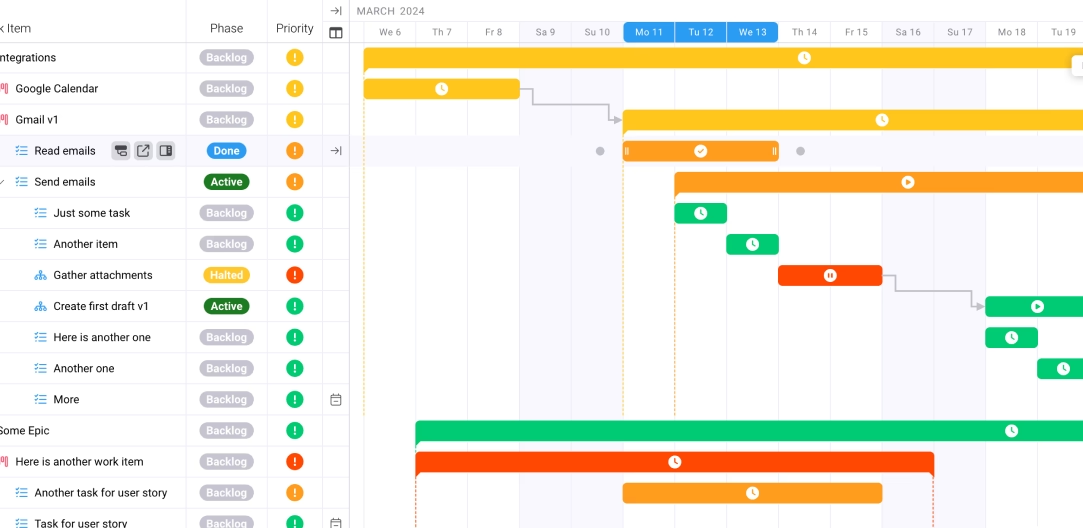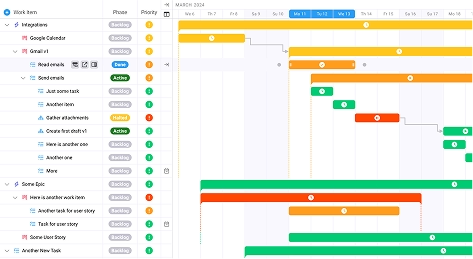
5 Best Project Management Tools With Multiple Assignees
Key takeaways:
- Multiple assignee functionality transforms how teams collaborate on complex deliverables by enabling shared responsibility without sacrificing accountability
- Advanced project management platforms now support role-based task assignment, allowing different team members to contribute specific expertise to the same deliverable
- Organizations using collaborative project management tools report 30% faster project completion times and significantly improved team communication
- The best tools for multiple assignees combine clear ownership hierarchies with flexible collaboration features that adapt to different working styles
Believe it or not, there are lots of project teams that struggle with one critical challenge: assigning multiple team members to the same task without creating confusion or accountability gaps. While traditional project management tools treat task assignment as a one-to-one relationship, the reality of modern project management tools with multiple assignees demands a more sophisticated approach to collaborative work distribution and coordination. However, not all multiple assignee features are equal.
The Current Challenge: When Traditional Task Assignment Fails
The conventional project management approach of assigning one task to one person has become increasingly obsolete. Today’s teams are more diverse, dispersed, digital, and dynamic, with frequent changes in membership and complex interdependencies that require multiple skill sets for successful completion.
Research reveals that collaborative activities has ballooned by 50% or more over the past two decades, creating an urgent need for tools that can handle the complexity of modern team-based work. The problem isn’t just about assigning multiple people to tasks—it’s about creating systems that maintain clarity, accountability, and progress visibility when several team members are contributing different elements to the same deliverable.
Project managers on average simultaneously lead five to six projects, and traditional task assignment methods simply cannot handle the intricate web of responsibilities that characterize today’s project landscape. When multiple team members need to collaborate on deliverables—whether it’s a marketing campaign requiring input from strategists, designers, and copywriters, or a software feature needing developers, testers, and product managers—the limitations of single-assignee systems become glaringly apparent.
The consequences of inadequate multiple assignee support extend beyond mere inconvenience. Teams experience communication breakdowns, duplicated efforts, missed deadlines, and accountability confusion that can derail entire projects. Organizations need project management tools with multiple assignees that provide structured collaboration while maintaining clear ownership and progress tracking.
The Strategic Framework: Redefining Task Assignment for Team Success
Effective multiple assignee project management requires a fundamental shift from task-centric to outcome-centric thinking. Instead of asking “who will do this task,” the question becomes “what roles and skills are needed to achieve this outcome, and how can we coordinate their contributions effectively?”
Transformations are 5.3 times more likely to be successful when senior leaders role model behavior changes, and the same principle applies to project management tool adoption. Success depends on implementing frameworks that support both individual accountability and collaborative contribution.
The most effective approach combines three essential elements: role-based assignment, contribution hierarchy, and collaborative workflows. Role-based assignment ensures that each team member understands their specific contribution and expertise area. Contribution hierarchy establishes clear ownership and decision-making authority even when multiple people are involved. Collaborative workflows provide structured processes for communication, review, and integration of different team members’ work.
Modern project management tools with multiple assignees must support these framework elements through features like role-specific dashboards, automated workflow routing, and integrated communication systems. The goal is creating an environment where multiple contributors can work efficiently together while maintaining the clarity and accountability that drives project success.
Implementation Tactics: Five Essential Tools for Multiple Assignee Success
1. Ravetree: The All-in-One Agency Powerhouse
Ravetree stands out as the premier choice for organizations requiring sophisticated multiple assignee capabilities. Unlike tools that treat collaboration as an afterthought, Ravetree was built from the ground up to support complex team dynamics and multiple contributor workflows.
The platform’s strength lies in its comprehensive approach to project management that seamlessly integrates task assignment with resource planning, time tracking, and client communication. Teams can assign multiple members to deliverables while maintaining clear role definitions and contribution tracking.
What sets Ravetree apart is that you’re not just assigning multiple people to each task. You can also specify the work role for each assignee, different time estimates, and even different bill rates. Furthermore, each task can have an “owner”, which can be different from the assignees. All of this become critically important when it comes time to billing, analyzing fees & costs, and resource planning. Most other tools only allow you to assign multiple people to a task, while assuming that everything else is equal. Ravetree’s capabilities around multiple assignees ensures accountability while helping managers balance workloads and prevent bottlenecks.

Tools and frameworks that support multiple assignees for campaign coordination have become essential for agencies managing complex client deliverables. Ravetree’s integrated approach means teams can handle everything from initial strategy sessions with multiple stakeholders to final delivery with various specialists—all within a single, coherent system.
2. Smartsheet: Enterprise-Grade Flexibility
For organizations requiring enterprise-level scalability and customization, Smartsheet provides robust multiple assignee functionality within a familiar spreadsheet-style interface. The platform excels at handling complex projects where different team members contribute specialized expertise to shared deliverables.
Smartsheet’s multiple assignee features include advanced dependency mapping, automated workflow routing, and customizable approval processes. Teams can create sophisticated assignment matrices that define exactly who contributes what to each deliverable, when their input is needed, and how their work integrates with other team members’ contributions.
The platform’s real strength emerges in complex, multi-phase projects where different specialists need to collaborate on deliverables at different stages. Marketing teams can assign campaigns to strategists for initial concepts, designers for creative execution, copywriters for content development, and account managers for client coordination—all with clear timelines and interdependencies.
3. Microsoft Project: Powerful Resource Management
Microsoft Project remains a top choice for organizations that need sophisticated resource management capabilities combined with multiple assignee functionality. The platform’s advanced scheduling engine can handle complex scenarios where multiple team members contribute different amounts of effort to shared tasks.
The tool’s resource allocation features allow project managers to assign partial capacity from different team members to the same deliverable, creating realistic timelines that account for everyone’s availability and contribution level. This capability proves invaluable for organizations where specialists split their time across multiple projects and deliverables.
Microsoft Project’s integration with the broader Microsoft ecosystem means teams can leverage familiar tools like Teams for communication, SharePoint for document collaboration, and Power BI for advanced reporting on multiple assignee productivity and project outcomes.
4. Teamwork: Collaboration-First Design
Teamwork takes a collaboration-first approach to multiple assignee functionality, providing intuitive features that make team coordination feel natural rather than forced. The platform’s strength lies in its user-friendly interface that doesn’t sacrifice power for simplicity.
The tool’s multiple assignee features include collaborative task boards, integrated team messaging, and flexible assignment options that support both shared responsibility and clear ownership. Teams can create tasks with multiple assignees while designating task owners who maintain ultimate accountability for deliverable completion.
Teamwork’s collaborative features extend beyond basic task assignment to include shared project spaces, team calendars, and integrated file sharing that keeps all multiple assignee communication and resources centralized and accessible.
5. Basecamp: Streamlined Team Coordination
For teams prioritizing simplicity and ease of adoption, Basecamp offers straightforward multiple assignee functionality without overwhelming complexity. The platform focuses on essential collaboration features that help teams coordinate effectively without getting lost in advanced functionality they may not need.
Basecamp’s approach to multiple assignees emphasizes communication and shared visibility rather than complex workflow automation. Teams can include multiple people on tasks, projects, and discussions while maintaining clear communication threads that keep everyone informed about progress and changes.
The platform’s strength lies in its ability to bring together distributed team members around shared deliverables through simple, intuitive tools that require minimal training or setup time.
Measuring Success: KPIs and Metrics That Matter
Implementing project management tools with multiple assignees requires careful measurement to ensure the investment delivers expected benefits. 77% of high-performing projects utilize project management software, but success depends on tracking the right metrics.
Team Collaboration Metrics
Collaborative teams are 5 times more likely to be high-performing in creativity and innovation, making collaboration quality a critical success indicator. Key metrics include response time to teammate requests, cross-functional project completion rates, and team satisfaction scores related to task assignment clarity.
Organizations should track assignment distribution balance to ensure workload equity across team members. Tools should provide visibility into how tasks are distributed among multiple assignees and whether certain team members are consistently over or under-utilized.
Project Delivery Performance
Effective deliverable management requires clear task assignment and accountability systems, making delivery metrics essential for evaluating multiple assignee effectiveness. Track completion rates for tasks with multiple assignees compared to single-assignee tasks, measuring whether collaborative assignment improves or hinders delivery performance.
Quality metrics become particularly important when multiple team members contribute to the same deliverable. Monitor revision cycles, client satisfaction scores, and deliverable approval rates to ensure that multiple assignee workflows maintain or improve output quality.
Resource Utilization and Efficiency
Global survey of 4,069 people involved in leading project delivery reveals that resource optimization remains a critical challenge. Organizations should measure utilization rates across team members to ensure multiple assignee functionality improves rather than complicates resource management.
Time-to-completion metrics help evaluate whether multiple assignee workflows accelerate or slow project delivery. Compare timeline performance for similar projects using different assignment approaches to identify optimal collaboration patterns.
Future Considerations: Emerging Trends and Next Steps
The evolution of project management tools with multiple assignees continues accelerating as organizations embrace more complex, collaborative work structures. Artificial intelligence integration promises to revolutionize assignment optimization, automatically suggesting ideal team combinations based on historical performance data and current workload analysis.
Remote and hybrid work models are driving demand for more sophisticated collaboration features within project management platforms. Tools must support asynchronous contribution from multiple assignees while maintaining project momentum and clear communication threads.
Integration capabilities will become increasingly important as organizations use specialized tools for different aspects of project delivery. The best project management tools will seamlessly connect with design platforms, communication tools, and CRM systems to support end-to-end workflows that span multiple team members and tool ecosystems.
Consider pilot programs that test different multiple assignee approaches with small teams before rolling out organization-wide implementations. This allows teams to identify optimal workflows and configure tools to match actual working patterns rather than theoretical ideals.
The future belongs to organizations that can effectively coordinate multiple specialists around shared deliverables while maintaining clarity, accountability, and momentum. By selecting and implementing project management tools with multiple assignees that support these requirements, teams can unlock new levels of collaborative productivity and project success. Success in today’s complex project environment demands tools that embrace rather than resist the reality of team-based, collaborative work that defines modern organizational success.
Frequently Asked Questions
Q: How do multiple assignee tools prevent accountability confusion?
The best tools establish clear ownership hierarchies where one person maintains ultimate responsibility while others contribute specific expertise or support roles.
Q: What’s the difference between task sharing and multiple assignees?
Task sharing typically involves informal collaboration, while multiple assignee features provide structured role definition, contribution tracking, and integrated workflow management.
Q: Can multiple assignee tools work with existing project management processes?
Yes, leading platforms offer flexible configuration options that adapt to existing workflows while adding collaborative capabilities where needed.
Q: How do you measure productivity when multiple people work on the same task?
Track individual contribution hours, milestone completion rates, and overall deliverable quality to assess both individual and collective productivity.
Q: What happens when multiple assignees have conflicting priorities?
Advanced tools provide priority weighting, escalation workflows, and resource allocation features that help resolve conflicts before they impact project delivery.
Q: Are multiple assignee tools suitable for small teams?
While particularly valuable for larger organizations, small teams benefit from multiple assignee functionality when handling complex projects requiring diverse skill sets.









